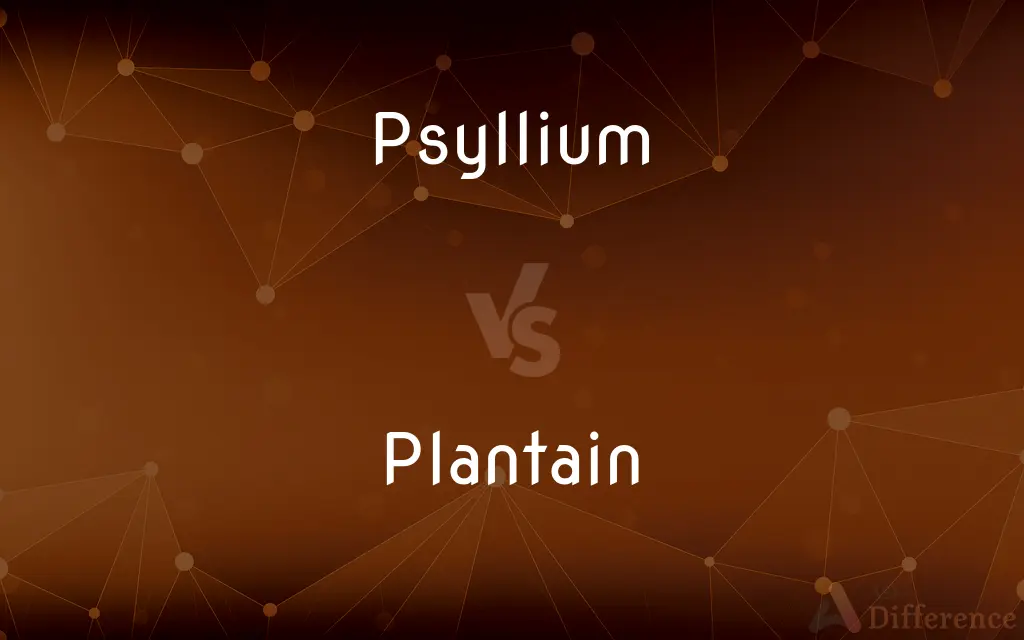Psyllium vs. Plantain — What's the Difference?
By Maham Liaqat & Urooj Arif — Updated on March 27, 2024
Psyllium is a fiber derived from Plantago ovata seeds, used for digestive health, while plantain refers to a group of plants or a starchy banana, depending on context, with diverse uses.

Difference Between Psyllium and Plantain
Table of Contents
ADVERTISEMENT
Key Differences
Psyllium husk, sourced from the seeds of the Plantago ovata plant, is primarily recognized for its high soluble fiber content, beneficial for bowel regularity and cholesterol management. Whereas plantains, often mistaken for bananas, are a staple food in many tropical regions, consumed cooked and valued for their versatility in culinary applications.
The primary application of psyllium is in dietary supplements and fiber products, aiming to improve digestive health and control blood sugar levels. On the other hand, plantains serve as a significant carbohydrate source in diets, especially in African, Caribbean, and Latin American cuisines, where they're fried, boiled, or baked.
Psyllium's effectiveness in managing constipation and promoting heart health by lowering cholesterol is well-documented. In contrast, plantains, although not specifically used for medicinal purposes, offer nutritional benefits, including vitamins A, C, and B6, and minerals like magnesium and potassium.
In terms of cultivation, Plantago ovata, the plant from which psyllium is derived, is primarily grown in India. Plantains, resembling bananas but larger and firmer, are cultivated in tropical regions worldwide, requiring warm climates to thrive.
Psyllium products are available in various forms, including powders, capsules, and husks, making it easy to incorporate into a dietary routine. Plantains, however, are generally consumed as a food item, requiring preparation and cooking before consumption.
ADVERTISEMENT
Comparison Chart
Source
Plantago ovata seeds
Musa genus plants
Primary Use
Dietary fiber supplement
Staple food in tropical diets
Health Benefits
Aids digestion, lowers cholesterol
Rich in vitamins and minerals
Form
Powder, capsules, husks
Whole fruit, cooked before eating
Nutritional Content
High in soluble fiber
High in carbohydrates, vitamins, minerals
Cultivation Area
Primarily India
Tropical regions worldwide
Consumption Method
Mixed with water or added to foods
Fried, boiled, or baked
Medicinal Applications
Used for constipation, heart health
Not specifically used for medicinal purposes
Compare with Definitions
Psyllium
A soluble fiber used as a dietary supplement for digestive health.
Adding psyllium to my diet has improved my digestion.
Plantain
Cultivated in tropical regions and used in diverse culinary applications.
Plantains are a staple in African culinary traditions, often boiled or grilled.
Psyllium
Extracted from the seeds of Plantago ovata.
Psyllium husks are a byproduct of Plantago ovata cultivation.
Plantain
A starchy banana-like fruit consumed cooked in many tropical diets.
Fried plantains are a delicious side dish in Caribbean cuisine.
Psyllium
Benefits blood sugar control.
Psyllium has helped me manage my blood sugar levels effectively.
Plantain
Provides a good source of vitamins A, C, and B6.
Plantains are not only versatile but also rich in essential vitamins.
Psyllium
Promotes bowel regularity and helps lower cholesterol.
Psyllium is recommended for its cholesterol-lowering effects.
Plantain
Offers minerals like magnesium and potassium.
Eating plantains can contribute to your daily intake of important minerals.
Psyllium
Can be incorporated into diets in powder or capsule form.
I mix psyllium powder into my smoothie every morning.
Plantain
Not eaten raw due to its starchiness.
Plantains are too firm and starchy to be eaten raw, unlike bananas.
Psyllium
Psyllium , or ispaghula (isabgol) , is the common name used for several members of the plant genus Plantago whose seeds are used commercially for the production of mucilage. Psyllium is mainly used as a dietary fiber to relieve symptoms of both constipation and mild diarrhea, and occasionally as a food thickener.
Plantain
A low-growing plant that typically has a rosette of leaves and a slender green flower spike, widely growing as a weed in lawns.
Psyllium
Any of several annual Eurasian plants of the genus Plantago, especially P. ovata or P. afra, having opposite leaves and small flowers borne in dense spikes.
Plantain
A banana containing high levels of starch and little sugar, which is harvested green and widely used as a cooked vegetable in the tropics.
Psyllium
The seed husks of any of these plants, widely used as a mild bulk laxative and sometimes added to foods as a dietary source of soluble fiber.
Plantain
The plant which bears the plantain.
Psyllium
Any of several plants of the subgenus Plantago subg. Psyllium, whose seeds are used commercially for the production of mucilage and their laxative properties.
Plantain
Any of various plants of the genus Plantago, having a basal rosette of leaves and dense spikes of small greenish flowers.
Psyllium
Synonym of psyllium (seed) husk, especially as a dietary supplement
Plantain
Any of several varieties of banana, especially Musa ×paradisiaca, having edible, starchy, elongated fruit.
Psyllium
Plantain of Mediterranean regions whose seeds swell and become gelatinous when moist and are used as a mild laxative
Plantain
The fruit of this plant, usually eaten cooked.
Plantain
A plant of the genus Plantago, with a rosette of sessile leaves about 10 cm (4") long with a narrow part instead of a petiole, and with a spike inflorescence with the flower spacing varying widely among the species. See also psyllium.
Plantain
A plant in the genus Musa, the genus that includes banana, but with lower sugar content than banana.
Plantain
The fruit of the plant, usually cooked before eating and used like potatoes.
Plantain
A treelike perennial herb (Musa paradisiaca) of tropical regions, bearing immense leaves and large clusters of the fruits called plantains. See Musa.
Plantain
The fruit of this plant. It is long and somewhat cylindrical, slightly curved, and, when ripe, soft, fleshy, and covered with a thick but tender yellowish skin. The plantain is a staple article of food in most tropical countries, especially when cooked.
Plantain
Any plant of the genus Plantago, but especially the Plantago major, a low herb with broad spreading radical leaves, and slender spikes of minute flowers. It is a native of Europe, but now found near the abode of civilized man in nearly all parts of the world.
Plantain
Any of numerous plants of the genus Plantago; mostly small roadside or dooryard weeds with elliptic leaves and small spikes of very small flowers; seeds of some used medicinally
Plantain
A banana tree bearing hanging clusters of edible angular greenish starchy fruits; tropics and subtropics
Plantain
Starchy banana-like fruit; eaten (always cooked) as a staple vegetable throughout the tropics
Common Curiosities
Are plantains healthier than bananas?
Plantains and bananas offer different nutritional profiles; plantains are higher in carbohydrates and nutrients due to their larger size but need to be cooked to be consumed.
How do you add psyllium to your diet?
Psyllium can be added to the diet by mixing its powder or husks into water, smoothies, or baked goods.
Can you eat plantains raw?
No, plantains are too starchy and firm to be eaten raw and are usually cooked.
What dishes can you make with plantains?
Plantains can be fried, boiled, baked, or grilled and are used in dishes like tostones, mofongo, and plantain chips.
Are plantains good for diabetes?
Plantains have a high carbohydrate content, so they should be consumed in moderation by individuals with diabetes.
What is psyllium used for?
Psyllium is used as a dietary fiber supplement to improve digestive health and lower cholesterol.
Can psyllium help with weight loss?
Psyllium may aid weight loss by increasing satiety and reducing appetite.
Is psyllium the same as a laxative?
While psyllium has laxative properties due to its fiber content, it's considered safer and gentler than synthetic laxatives.
How long do plantains take to ripen?
Ripening time for plantains varies by climate and ripeness at purchase but typically ranges from a few days to a week.
How is psyllium harvested?
Psyllium seeds are harvested from the Plantago ovata plant, dried, and then processed to separate the husks.
Does psyllium interact with medications?
Psyllium can interact with certain medications by affecting their absorption; it's best to take it at a different time than medication.
Is there a difference between psyllium powder and husks?
Psyllium powder is finer and mixes more easily with liquids, while husks are coarser and may provide a more pronounced texture.
What's the difference between cooking bananas and plantains?
Cooking bananas are softer and can sometimes be eaten raw, while plantains are starchier and always need to be cooked.
How do you store plantains?
Plantains should be stored at room temperature and can be refrigerated once ripe to slow further ripening.
Can psyllium cause allergies?
Although rare, some individuals may be allergic to psyllium and experience reactions.
Share Your Discovery

Previous Comparison
Maddening vs. Madding
Next Comparison
Rogue vs. ThiefAuthor Spotlight
Written by
Maham LiaqatCo-written by
Urooj ArifUrooj is a skilled content writer at Ask Difference, known for her exceptional ability to simplify complex topics into engaging and informative content. With a passion for research and a flair for clear, concise writing, she consistently delivers articles that resonate with our diverse audience.













































